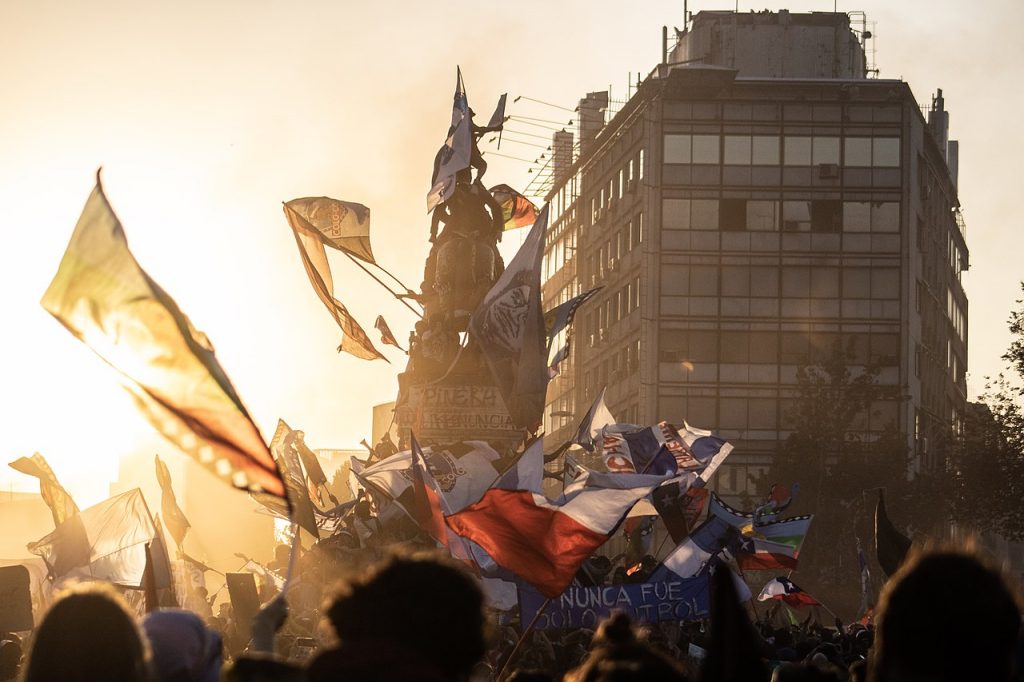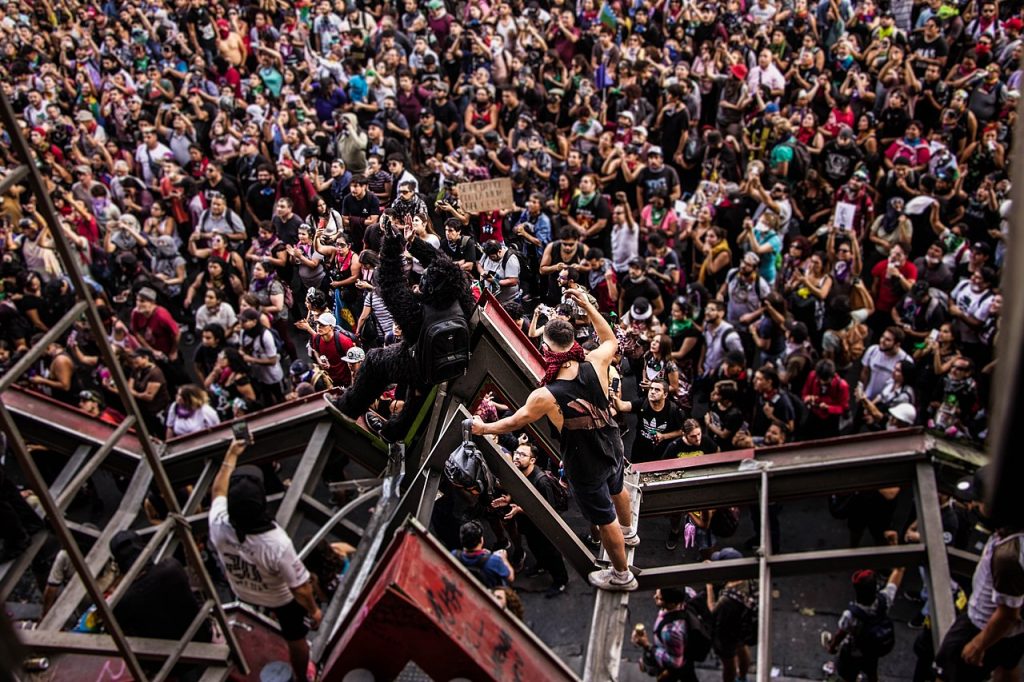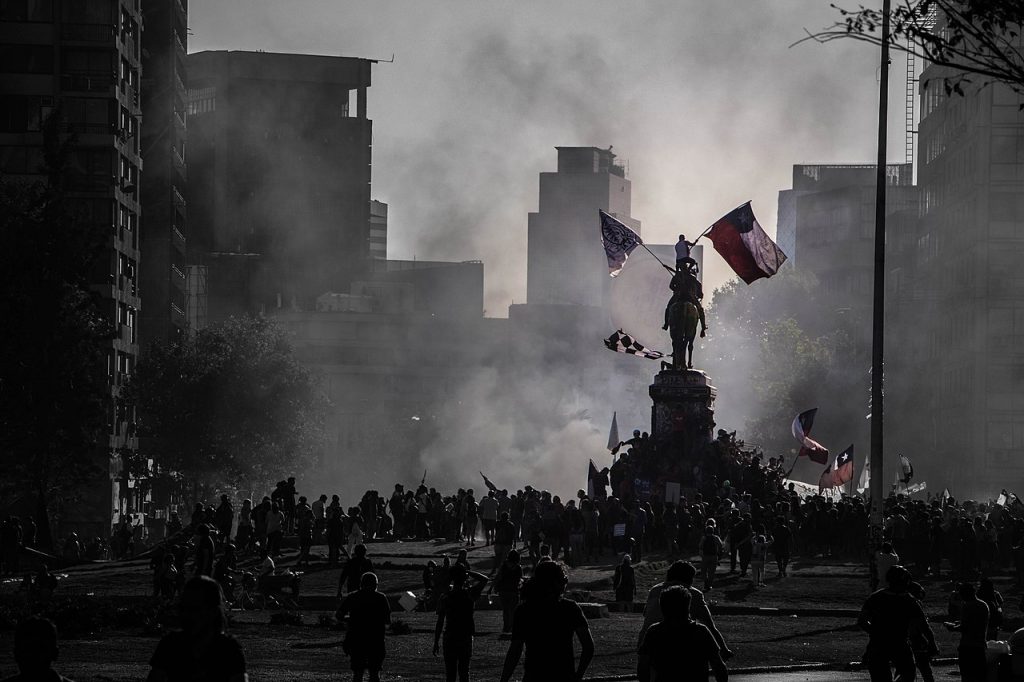The insurrection of October 2019 and the rapid spread of the COVID-19 since March 2020 have put Chile in a major historical juncture. To the political crisis triggered by the massive protests of last year, the pandemic has added a major social and economic crisis as unemployment and poverty levels soar. Undoubtedly, as a consequence of the popular protests, the government faced the COVID-19 crisis in a weak position that has severely affected its capacity to manage the health crisis. In a context of a sudden collapse of the economy and employment, the same networks that emerged during the insurrection –to organize rallies, mobilize protesters and counter repression– have rapidly transformed into solidarity networks that help local communities to cope with the worst consequences of the pandemic. In this short essay, I attempt to show that issues of space are central to understanding both the revolt and the unfolding of the COVID-19 crisis. Power asymmetries and inequalities manifest and reproduce through spatial patterns, which is especially true in a highly segregated city such as Santiago.
On 18 October 2019, thousands took to the streets to show their discontent with deep-rooted inequalities, a socioeconomic order perceived as leaning towards the interests of large corporations, and a political elite deemed unresponsive to social demands. Preceded by a series of protests led by secondary students against high transportation fees, unrest escalated into massive demonstrations and riots, which prolonged over several weeks. Santiago became the epicentre of the uprising, with protesters first occupying the city center and rapidly spreading to peripheral, working-class areas. Despite the declaration of state of emergency, with a curfew, military policing the streets and restrictions for public demonstrations, protests did not end. Indeed, one clear indicator of the magnitude of social unrest was the difficulties of the government to reassert control over the territory. Citizens challenged this strategy, repudiating the presence of the military and confronting with police forces when these attempted to clear the streets of protesters: power became an issue of who was able to assert their presence at the streets. Although their intensity and magnitude started to dwindle, especially in the face of Christmas, New Year’s Eve, and the summer break (January and February in the Southern Hemisphere), protests were far from disappearing.

A postcard from one of the evenings fighting in Plaza Baquedano. Photo: Wikimedia Commons/Gonzalo Mendoza
The main outcome of weeks of social unrest was an agreement signed on 15 November by most political parties. This agreement initiated a process for a new constitution that would replace the one written during Pinochet’s dictatorship. The process would start with a referendum dated for 26 April 2020. In this context, for the wide array of civil and political organizations that promote constitutional change by means of a fully elected assembly, the end of the summer signalled the beginning of an electoral campaign aimed at building a large, historical majority. However, on 2 March 2020 the authorities confirmed the first case of COVID-19 in the country. By the end of that month, president Sebastian Piñera declared a quarantine in a group of seven municipalities of the Santiago metropolitan area, while schools were closed and social distancing measures were initiated. In this new scenario, and given the difficulties of organizing an electoral event during the pandemic, the parliament decided unanimously to reschedule the constitutional referendum for October 2020.
The first government strategy to combat the spread of the virus were the “dynamic quarantines”, in which lockdown measures were to be applied exclusively in those municipalities (or even to sub-areas within them) where infections were growing. Such strategy relied on a high number of tests and effective systems of contact tracing to break transmission chains, which were never fully implemented. As infections and fatalities continued to rise, on 15 May the government was forced to extend the quarantine area to the whole metropolitan region of Santiago (population of 6.5 million) and other cities in the north and south. During these crucial weeks, the virus travelled from its initial hotbeds located in upper-middle class areas of Santiago (probably carried by citizens returning to the country after visiting Europe or Asia), to working class areas of the city. Replicating a pattern also seen in other countries, the municipalities with the highest infection and mortality rates are those with higher levels of poverty, overcrowding, and migrant populations.
Although Piñera’s administration did not deny the severity of the virus, as for example Jair Bolsonaro did in Brazil, government mismanagement is apparent four months after the first confirmed coronavirus case. By the end of June 2020, the total number of infections in Chile (300,000) has already overcome those of Italy or Spain, while the daily new confirmed COVID-19 deaths per million people has been one of the world highest throughout June, according to data gathered by the University of Oxford. The social and economic cost of the pandemic are immense. At the time of writing this research note, some areas of Santiago have been in a continued lockdown for more than 3 months, and the negative effects for the economy have become all-encompassing. According to the National Statistics Office, almost 1.5 million jobs have been lost between March and May 2020. The unemployment rate is on the rise and the workforce has shrunk (as thousands have withdrawn from the labour market during the lockdown). Overall, more than 60% of the workforce would be in a position of income vulnerability, according to the latest official statistics, and some researchers suggest that 80% of the population would be at risk.

Protesters listen live concert from Dignidad Radio Station. Photo: Wikimedia Commons/Marcellablues
The pandemic appears as an abrupt interruption of the political course initiated by the October 2019 insurrection, which materialised in the agreement for the initiation of a constitutional process. To understand the magnitude of the social upheaval we need to pay attention to the process of formation and activation of networks during the crucial weeks following 18 October. This process was extremely rapid, as social network websites and apps have reduced the burden of coordination and accelerated the diffusion of messages and frames of protest among large audiences. Social networks also provide a sense of horizontalism, which aligns with citizens’ inclination to mistrust the old (vertical) structures of authority –a feeling mobilized by student movements since 2011. Although the most iconic events of protest took place in the city center (especially around Plaza Italia, which protesters re-baptized as ‘dignity square’), several areas of the city witnessed spontaneous gatherings, demonstrations, clashes between police and demonstrators, even the looting of supermarkets and warehouses. Drawing on social networks data, Correa (2019) has shown that contentious events in the days following 18 October spread all over the city, and especially in working class areas. Furthermore, as the demand for a new constitution was central to the protests, citizens self-organized in groups (cabildos) to discuss the contents and principles that a new constitution should include. Inostroza (2019) has shown that these cabildos appeared in most areas of the city, also in popular areas. These data demonstrate that the October insurrection involved working and middle classes alike, and that the popular sectors were a central component of the movement, playing a crucial role during the event.
With the outbreak of COVID-19, these networks have rapidly transformed into solidarity networks whose main aim is to provide social and economic support to the communities affected by the pandemic. As the social situation has quickly deteriorated, a number of initiatives have emerged in several neighbourhoods, being one of the most important the soup kitchens (ollas comunes). For the younger generations, born after the end of the dictatorship (1990), soup kitchens represent a rather new phenomenon, but for those who experienced the economic crash of 1982-83, these were a widespread reality across popular areas in Santiago and other cities. In a similar vein, other groups have set up collection centers where they gather food, clothing and medicines from donations, to be distributed among persons in need; while others have organized sanitation brigades which clean common areas in overcrowded apartment buildings or in illegal settlements –where social distancing measures are not possible. To the appearance of these initiatives have contributed volunteers and activists mobilized by the new networks emerged in the aftermath of the October insurrection, but also many others from previously existing organizations. These organizations include the parties of the Left, student unions and informal colectivos of students and young activists, organizations related to the catholic church, and NGOs and charity organizations. These groups put their territories and local communities at the center, overlapping with other networks that connect their members to initiatives of a larger scale, at regional or national levels. At the beginning of June 2020, in Santiago alone there were 223 soup kitchens –for example, in the popular municipality of Puente Alto, soup kitchens have delivered 10 thousand meals in one day.

Dignidad square covered by the smoke of tear gas bombs. Photo: Wikimedia Commons/Marcellablues
The COVID-19 crisis no longer appears to be a short parenthesis in the economic and social life of the country, and most likely Chilean society will have to deal with its consequences for a long time. Some political figures related to the conservative right have attempted to use this crisis as an alibi to alter the pathway of constitutional reform agreed to last November, thus avoiding a major electoral defeat in the forthcoming referendum. In particular, they would like to concentrate the whole constitutional discussion in the parliament, where the old elite holds a majority –thanks to a meagre voter turnout of 45% in the last election, among other factors. However, with these attempts the old elite confirms the perceptions of most citizens regarding the unresponsiveness of political authorities, and the intimate connection between governments and the interests of the business elite.
The popular demands that took people to the streets last October remain unattended, and in some areas the government reaction to the COVID-19 crisis seems to be at odds with citizens’ priorities. Furthermore, the focus on direct social action and the lockdown have not totally prevented some communities to publicly express their discontent –as we have also seen in the US with the protests against police brutality and discrimination. There were food riots in some areas in Santiago in May, and other protests have taken place afterwards. As unemployment and poverty continue to increase, social discontent will expand and it is only a matter of time to see social conflict intensifying, yet probably taking other forms, as suggested by recent research on activism in times of the COVID-19.
In this short essay, I have attempted to show that by looking at the intersection of territory, inequalities, and popular mobilization, we can learn significant insights from contemporary processes of social and political change. It is not by chance that the urban areas mostly affected by the pandemic are those where the inequalities engendered by three decades of liberalization are more severe. Similarly, it is not by chance that grassroots activism has been particularly active in these territories, especially since the uprising of October 2019. While it is difficult to make predictions, it is clear that these intersections can have consequences in politics and society. Overall, the juxtaposition of an unsettled political crisis, the health crisis, and the economic crash derived from the pandemic, configures a highly volatile situation.
César Guzmán-Concha (Twitter) is a Marie Skłodowska-Curie fellow (Institute of Citizenship Studies, University of Geneva), and principal investigator in the project “Mobilizing for Basic Incomes: Social Innovation in Motion”. As a comparative political sociologist, he has investigated topics related to power, conflict and social change both in European and Latin American countries.
Acknowledgements
This project has received funding from the European Union’s Horizon 2020 research and innovation programme under the Marie Sklodowska-Curie grant agreement No 839483, MOBILISE.
All essays on Urban Revolts
Introduction: The Spatiality of Street Protests before and during Covid-19
Liza Weinstein
When the Pandemic Meets the Insurrection. Santiago, Chile
César Guzmán-Concha
Urban Revolutions: Lebanon’s October 2019 Uprising
Mona Fawaz & Isabela Serhan
The Revolt of the “Periphery” Against the “Metropolis”? Making Sense of the French Gilets Jaunes Movement (2018-2020)
Claire Colomb
An Urban Perspective on the Colombian “Paro Nacional”
Sergio Montero & Isabel Peñaranda
The Predicament of Hong Kong and the Spatial Expanse of Territorial Governance
Carolyn Cartier
Related IJURR articles on Urban Revolts
Institutionalization and Depoliticization of the Right to the City: Changing Scenarios for Radical Social Movements
Sergio Belda-Miquel, Jordi Peris Blanes and Alexandre Fredian
Do‐it‐yourself urbanism and the right to the city
Kurt Iveson
Glocalizing protest: urban conflicts and the global social movements
Bettina Köhler, Markus Wissen
Permitting Protest: Parsing the Fine Geography of Dissent in America
Don Mitchell, Lynn A. Staeheli
The Urban Question Revisited: The Importance of Cities for Social Movements
Walter J. Nicholls
Urban Segregation and Metropolitics in Latin America: The Case of Bogotá, Colombia
Joel Thibert, Giselle Andrea Osorio
© 2020 THE AUTHOR. INTERNATIONAL JOURNAL OF URBAN AND REGIONAL RESEARCH, PUBLISHED BY JOHN WILEY & SONS LTD UNDER LICENSE BY URBAN RESEARCH PUBLICATIONS LIMITED
This is an open access article under the terms of the Creative Commons Attribution-NonCommercial-NoDerivs License, which permits use and distribution in any medium, provided the original work is properly cited, the use is non-commercial and no modifications or adaptations are made.
